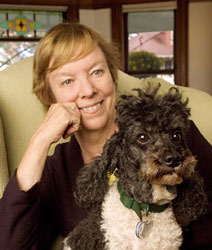Dealing with fear
I’ve had a lot of dogs in my life, Labradors and poodles and Great Danes and Border terriers, a Weimaraner, a collie, a golden, and a great mutt named Goulash. But I never had a fearful dog—until the current Dog-in-Residence, Misha, my German spotted poodle. He’s ten years old now, and still panics at every sudden sound or strange sight. If a new person or a new piece of furniture comes into the house, Misha has to lift his leg somewhere. If I’m too preoccupied by work, or, God forbid, annoyed with Misha, he vomits and has diarrhea, usually on the dining room rug, which of course makes me more annoyed.

Help from England
Then I read Kay Laurence’s perceptive and amusing new book, Teaching with Reinforcement. Using her own cluster of sheep dogs and Gordon setters, Kay demonstrates the ways in which our everyday life with our dogs is riddled with both reinforcement and punishment contingencies we may not notice or understand.
I watched Misha for a few days and discovered that a LOT of my "normal" behavior is punishing to Misha. Even his name can be aversive: "Oh Misha, did you do that AGAIN?" Misha is entirely manageable, he knows a lot of tricks, his human and dog manners are splendid—but we need some higher thinking here. Goal: no more anxious looks and slinking around the house. I want daily merriment.
I started by seeing if I could help Misha have a whole day without feeling fear. It turns out that I can. When he pulls back and freezes at something—my briefcase in a new place in the car for instance—I used to think “Oh Misha, get over it.” Then I’d lift him into the car manually. Now I’m learning to give him time to study the situation and cope with it at his own speed. So that reduces some of our chronic conflict.
Help from Sweden
Next I read the final manuscript of a wonderful new clicker book we are publishing in January, Agility Right from the Start, by Swedish trainers Eva Bertilsson and Emelie Johnson Vegh. Here are step-by-step instructions for teaching a dog how to play with toys (teaching an owner to play, too, a lesson I sorely needed). I broke out the clickers and some new, tiny, star-shaped treats that Misha loves. I carefully shaped taking and holding a small ball.
We did that for two weeks, ten minutes a night. Then suddenly, one day at the office, Misha found a tennis ball and exploded into ball play, chasing the ball up and down the halls, throwing the ball on his own, dropping it at my feet for me to throw. Yay Misha! Now he plays with all kinds of toys, even new, strange toys that he used to avoid. Click here to see Misha playing with his new Pogo Plush toy.
Misha and Karen’s excellent Christmas present
But wait, there’s more. In their book, Eva and Emelie have given us a precise set of clicker exercises for gradually teaching a dog to enjoy making things clatter and bang—knocking down a pile of metal bowls, say. When a dog learns to earn clicks and really delicious treats by making noise himself, then noisy events and mishaps on the agility field—jumps falling over, the teeter banging, loudspeakers nearby, and so on—become far less disturbing. Of course it would be the same in everyday life, too. So that’s my Christmas present to Misha: we’re going to do all the exercises in Eva and Emelie’s new agility book for teaching a dog to love a commotion.
And you know what? Being obliged to have some clicker fun with my now-elderly dog is Misha’s Christmas present to me.
Here’s good news for all of us:
- Kay Laurence will be joining us again at ClickerExpo this season AND she’s teaching a Session on play.
- Eva Bertilsson and Emelie Johnson Vegh will also be at ClickerExpo, teaching four amazing clicker Sessions and workshops based on Agility Right from the Start. Join us!
Happy clicking,
Karen Pryor



Post new comment